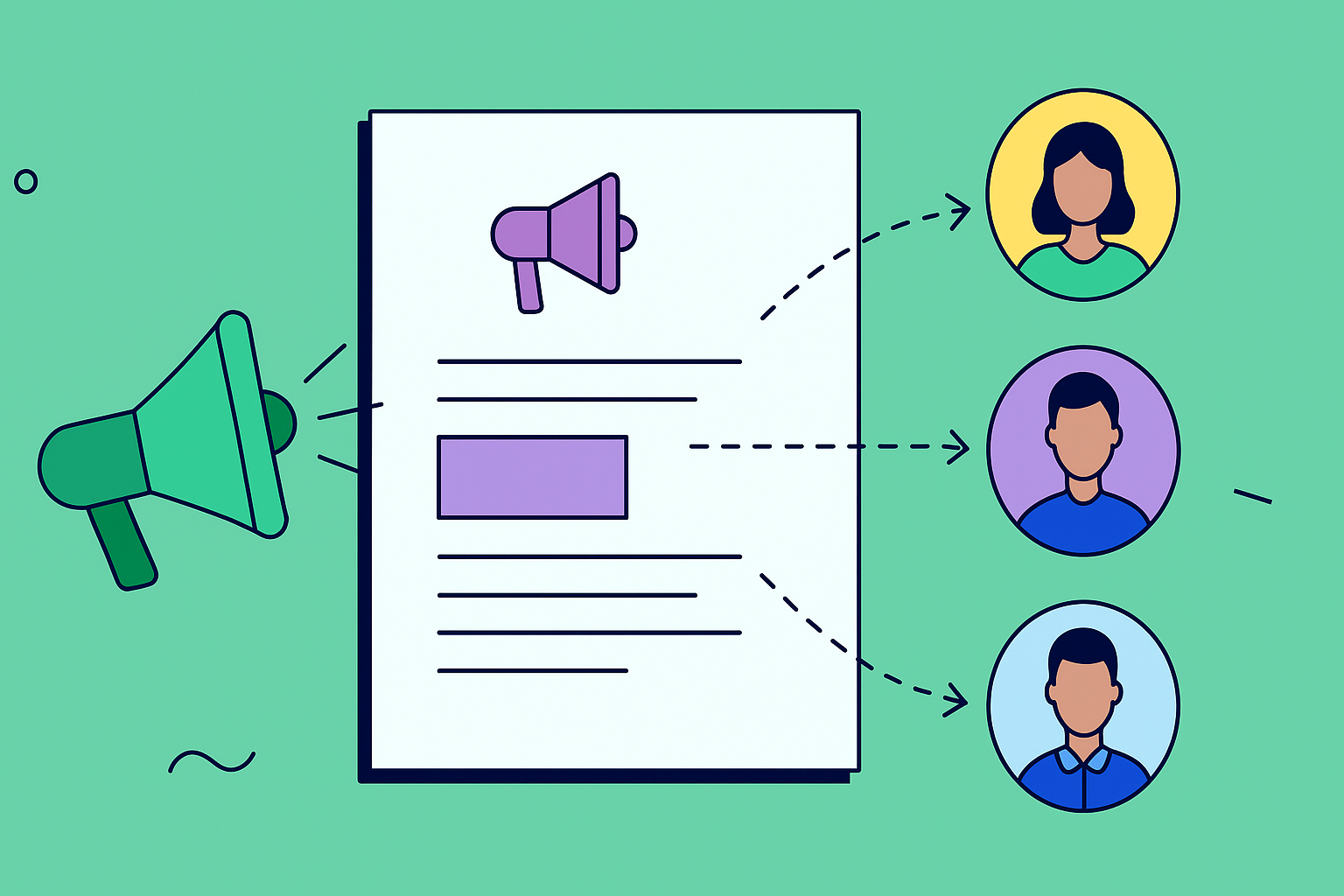We’ve all heard the cliché “communication is key,” but in project management, that’s only half the story. The real problem isn’t usually a lack of communication. It’s the wrong kind—disorganized, misaligned, and shot off to the wrong people. This chaos is the silent killer of project timelines and budgets.
A project communication plan template is the strategic blueprint you need to prevent this slow-motion failure. It’s about ensuring the right message reaches the right stakeholder at the perfect time.
Why Your Project Is Quietly Failing
Let’s be honest: most projects don’t fail with a spectacular bang. They just quietly drift off course. This happens when expectations are misaligned, information gets stuck in silos, and updates are a disorganized mess.
Think about it. A developer gets a last-minute change request from an executive who wasn’t part of the initial tech review. A key stakeholder completely misses a critical risk report because it was buried in a 50-reply email chain.

These aren’t just one-off mistakes. They’re symptoms of a much bigger issue: the complete absence of a structured communication strategy. This isn’t about sending more emails or scheduling more meetings. It’s about creating intentional clarity.
The Real Cost of Unplanned Communication
When there’s no plan, every update becomes a frantic guessing game. Who needs to know this? How much detail should I include? Should this be a Slack message, an email, or a formal report? This ambiguity is expensive, leading directly to:
- Budget Overruns from all the rework required to fix misunderstood requirements.
- Missed Deadlines because teams are stuck waiting for approvals or information that never shows up.
- Decreased Morale as team members feel unheard, unappreciated, and totally out of the loop.
A project communication plan isn’t more bureaucracy. It’s your project’s insurance policy against the slow, quiet failures that plague even the most promising initiatives. It transforms communication from a constant headache into a strategic advantage.
A Strategic Blueprint for Success
A good communication plan template acts as your guide. It forces you to think through who needs information, what they need to know, how you’ll deliver it, and how often.
For example, your executive sponsor might only need a high-level, one-page summary each week. Your core development team, on the other hand, needs detailed notes from the daily stand-up. For more ideas on this, check out our guide on internal communication best practices.
The impact of this simple structure is massive. Research shows that project teams with a formal plan complete their work 28% faster than those without one. This powerful statistic proves how a simple document can dramatically accelerate your progress.
Consider this your intervention. It’s time to stop the quiet failures before they even start.
Identifying Who Really Needs to Know What
Before you type a single word of an update or book a single meeting, you need to get one thing straight: who are you even talking to? A solid communication plan isn’t built on wishful thinking; it’s built on a deep, almost forensic, understanding of your audience. Just listing names on a spreadsheet is a rookie mistake. You need to map out who needs to know what, when they need to know it, and why it even matters to them.
This all starts with a proper stakeholder analysis. Forget just listing out your team and the C-suite. This is a strategic exercise in mapping power dynamics, personal interests, and specific information needs. Who holds the purse strings? Who can throw up a roadblock that stops you dead in your tracks? And, just as importantly, whose daily work will be completely upended by this project?
Don’t dismiss this as administrative busywork. Getting this right from the start can boost your project’s success rate by as much as 35%. It’s the difference between critical information reaching the right people and key partners being left in the dark.
Mapping Influence and Interest
Let’s be real: not all stakeholders are created equal in the context of your project. A huge part of a project manager’s job is sorting them out based on two simple but powerful factors: their influence over the project and their interest in its outcome.
Think about a major software launch.
- The CEO has sky-high influence (they can pull the plug) but might have pretty low day-to-day interest. They just want the big picture, not the nitty-gritty details.
- A lead developer, on the other hand, has less formal power but an incredibly high interest. They live and breathe the technical details and need to be in the loop constantly.
- The marketing manager sits somewhere in the middle, with high interest and moderate influence. They desperately need feature updates and launch timelines to do their job effectively.
This simple infographic breaks down the basic flow of this thinking.
Seeing it visually makes it clear. Pinpointing your stakeholders is just the first step. The real magic happens when you figure out what they need to hear and how often they need to hear it.
From Analysis to Action
Once your map is complete, it’s time to turn that analysis into a concrete plan. This is where a stakeholder communication matrix comes in—it’s the beating heart of any good project communication plan. This tool directly links each person or group to a specific communication strategy.
The whole point is to hit that sweet spot between spamming everyone with irrelevant details and leaving key people in an information vacuum. Sending a detailed bug report to your CEO is just as useless as telling your tech lead, “things are going well.”
Let’s put this into practice using our software launch example. We can organize our stakeholders into four main groups, which helps us decide exactly how to communicate with them.
Here is a simple matrix that breaks it down:
Stakeholder Communication Matrix Example
| Stakeholder Quadrant | Description | Communication Strategy | Example |
|---|---|---|---|
| High Influence / High Interest | The key players you need to manage closely. Their support is critical for success. | Engage constantly with frequent, detailed updates. Think weekly one-on-one meetings and direct access for questions. | Project Sponsor |
| High Influence / Low Interest | Powerful people who don’t need the daily details but must be kept happy. | Provide concise, high-level summaries. A bi-weekly executive dashboard or a quick mention in a leadership meeting works perfectly. | CEO |
| Low Influence / High Interest | People who are heavily impacted by the project but don’t have much say in its direction. | Keep them informed about how the project will affect them. Regular newsletters, FAQ docs, and dedicated feedback channels are great. | End-Users (in a beta test) |
| Low Influence / Low Interest | People on the periphery who don’t need much information. | Monitor with minimal effort. A general company-wide announcement at project completion might be all that’s needed. | An internal department not directly impacted |
This targeted approach takes the guesswork out of your communications.
By sorting stakeholders this way, you ensure every email, report, and meeting is actually relevant and makes an impact. For more great ideas, you can dive deeper into our complete guide on stakeholder engagement strategies.
Alright, let’s get down to business. Moving from theory to a real, working communication plan is where the rubber meets the road. Forget those dusty, generic documents and forgotten spreadsheets. A truly effective project communication plan template isn’t a static file—it’s a living, breathing tool you craft with purpose.
It’s all about setting clear goals, finding a rhythm for your updates, and making sure every single person knows their part in keeping information flowing smoothly. This is so much more than just figuring out who sends the weekly email. It’s about building a system that heads off miscommunication before it even has a chance to start.
Let’s break down how to build this thing, piece by piece. The goal is to create a solid framework you can tweak for any project, whether it’s a quick marketing push or a massive, complex software launch.
First Things First: What Are Your Communication Goals?
Every single piece of communication needs a purpose. Before you even think about the what and the how, you have to nail down the why. What are you actually trying to accomplish with your updates? And please, don’t just say “keep everyone informed.” We need to get way more specific than that.
Are your goals to:
- Secure buy-in? This means making sure stakeholders feel heard and are confident in where the project is headed.
- Mitigate risks? It’s about proactively sharing potential problems and working on solutions together.
- Drive action? This is all about giving people the clear, timely info they need to do their jobs.
- Maintain alignment? The key here is keeping different teams in sync on progress and what’s coming next.
Nailing down these goals from the get-go will shape every other decision you make. For instance, if a primary goal is to “mitigate risks,” your plan absolutely must include a fast-track channel for urgent issues, completely separate from your regular weekly check-ins.
A well-defined goal transforms communication from a reactive chore into a proactive strategy. It’s the difference between just sending updates and actually achieving results.
Outline Your Key Messages and Cadence
With your goals locked in, it’s time to map out the specific messages for each stage of your project. Think through the entire project lifecycle—from kickoff and execution to launch and the final wrap-up. The information your team needs at the kickoff meeting is worlds away from what’s critical during that final push to the finish line.
Let’s imagine a real-world scenario, like a construction project:
- Kickoff Phase: Your messages are all about the big picture: scope, budget, high-level timelines, and introducing the core players. The cadence is frequent to build that initial momentum.
- Execution Phase: Now, the focus shifts. You’re sending out weekly progress reports, tracking the budget, and flagging any risks. The cadence becomes regular and predictable—like a status report that lands in everyone’s inbox every Friday, no exceptions.
- Closeout Phase: Communication now centers on final inspections, reconciling the budget, and—crucially—documenting lessons learned. The cadence might slow down here, focusing on tying up loose ends.
This approach guarantees your stakeholders get information that’s actually relevant to what’s happening right now. For a deeper look at creating these documents, you might find our detailed communication plan template guide helpful, as it’s packed with more examples.
Assign Clear Ownership and Responsibility
A plan without owners is just a wish list. It’s that simple. Every single communication task needs a name attached to it. Who is responsible for putting together the weekly status report? Who sends out meeting minutes? Who’s in charge of updating the project management tool? Any gray area here is a recipe for dropped balls and confusion.
This isn’t about micromanaging; it’s about creating a culture of accountability. When the marketing lead knows they own the campaign metrics report every Tuesday, and the development lead knows they’re responsible for the daily stand-up summary, the system practically runs itself.
Using templates is a huge advantage here. They give you a reusable framework so you aren’t constantly reinventing the wheel for every project. As one resource from Asana points out, this efficiency is a major benefit, freeing up teams to focus on the actual work, not administrative busywork. You can learn more about building reusable communication plans on Asana.com. This simple act of assigning ownership ensures your plan gets followed consistently, making it the reliable source of truth for the entire project team.
Choosing the Right Tools for the Message

Let’s be honest. A critical risk alert should never get buried in a routine weekly newsletter. In the same vein, you wouldn’t call an all-hands meeting just to announce you’ve ticked off a minor task.
This is the art of matching the message to the medium, and it’s a cornerstone of any communication plan that actually works. The goal here is to be strategic, not just fire off updates into the void and hope the right people see them.
High Urgency vs. Low Urgency
Think about a real-world scenario. Your team just discovered a critical budget miscalculation that puts the entire project in jeopardy. This is a high-urgency, high-impact message.
- Wrong Channel: Dropping it in the “Notes” section of your project management tool. It’ll get lost.
- Right Channel: An instant message in a dedicated leadership channel (think Slack or Teams), immediately followed by an emergency meeting on the calendar.
Now, contrast that with a routine update, like the design team completing their first round of mockups. It’s important, but it’s not a five-alarm fire. A formal email summary or a scheduled update in your project management software is perfect. It creates a paper trail without causing unnecessary panic.
The core principle is simple: the channel must respect the recipient’s attention. When you misuse channels, you create notification fatigue, and soon enough, even your most critical alerts get ignored.
Synchronous vs. Asynchronous Communication
Another key decision is whether you need to talk in real-time (synchronous) or if the message can be sent now and reviewed later (asynchronous).
- Synchronous (Live): This is your go-to for complex problem-solving, brainstorming sessions, and sensitive conversations. Think video calls and in-person meetings. A well-run meeting is a powerful tool for building consensus. For advice on that, check out our guide on how to conduct productive meetings.
- Asynchronous (Delayed): This is ideal for status updates, sharing documents for review, and general announcements that don’t require an immediate response. This category includes emails, comments in project tools, and recorded video messages. It’s the perfect way to respect different time zones and work schedules.
Picking the right tool isn’t just about being efficient; it’s about being effective. Research shows that using the right channels for the right message can improve information retention by a whopping 45%. That’s a massive boost for project clarity. Discover more insights about project communication effectiveness on 6sigma.us.
By clearly defining these channels in your project communication plan, you eliminate the guesswork. You build a reliable system that keeps everyone in the loop without completely overwhelming them.
Bringing Your Communication Plan to Life
Let’s be honest. A beautifully crafted communication plan is completely worthless if it just collects digital dust in a forgotten folder. The real challenge isn’t just making the plan; it’s weaving it into the very fabric of your project so it becomes a living, breathing guide for everyone involved. To make it stick, you need genuine buy-in from the very beginning.

The best way I’ve found to do this is to dedicate real time to it during your project kickoff meeting. Don’t just attach it to an email and hope for the best. Walk your team and stakeholders through it. Explain the “why” behind your channel choices and the cadence you’ve set. Answering questions face-to-face turns a document into a shared agreement. If you need some help structuring that first critical meeting, this project kickoff agenda is a great starting point.
Navigating Roadblocks and Staying Agile
Even the most thorough plan will hit a few bumps. Priorities will shift, key stakeholders will go quiet, and unexpected problems will pop up. The secret is to treat your communication plan not as a rigid set of laws, but as an adaptable framework that can bend without breaking.
So, what happens when a crucial stakeholder suddenly goes silent?
- First, don’t assume the worst. Before anything else, check your plan. Are you actually using their preferred communication channel? Is the information you’re sending still relevant to their role?
- Try a direct, personal approach. Often, a quick, simple message asking if the current update schedule is still working for them is all it takes to open the lines of communication again.
- Re-evaluate their position. It’s possible their involvement in the project has changed. A short conversation can help you understand their new reality and adjust the plan accordingly.
Your communication plan has to be a living document. I recommend scheduling quick, quarterly check-ins with your core team to ask one simple question: “Is this still working for us?” This feedback loop is your best defense against the plan becoming irrelevant.
Keeping the Plan Powerful and Relevant
Getting the plan off the ground is one thing; maintaining its momentum is another. Your plan needs to evolve alongside the project itself. Every time you hit a major milestone or the project’s scope changes, make it a habit to revisit the communication plan and see what needs a tune-up.
So many projects go off the rails because of poor communication—things like inconsistent updates, last-minute surprises, and messages that get lost in the noise. A well-defined communication plan is your single best tool for managing these risks.
Ultimately, your goal is to keep the plan from becoming just another piece of project bureaucracy. By introducing it with a clear purpose, adapting it to new challenges, and constantly asking for feedback, you ensure it remains a powerful tool that drives clarity and accountability from kickoff to closeout.
Frequently Asked Questions
Even with the best guide, you’ll always have a few specific questions pop up. That’s normal. Here are some straightforward answers to the questions project managers ask us the most when they’re building out their communication plans.
What Are the Absolute Must-Have Elements in Any Communication Plan?
If you strip a communication plan down to its bare essentials, what’s left? Every solid plan, no matter the project’s scale, rests on a few core pillars. Without them, things tend to fall apart quickly.
Make sure your plan includes, at a minimum:
- A Stakeholder Register: This is more than just a list of names. It needs to define their influence, their level of interest, and exactly what information they need to get from you.
- Clear Communication Objectives: These should link directly to the project’s main goals. Think tangible outcomes like “ensure timeline alignment with the dev team” or “mitigate budget risks by keeping the CFO informed.”
- Defined Channels and Cadence: This is the how and how often. Spell out whether updates will be sent via email, a Slack message, or a formal meeting, and specify if it’s a daily, weekly, or bi-weekly check-in.
- An Escalation Path: When something urgent blows up, everyone needs to know precisely who to contact. This avoids panic and ensures problems don’t sit unanswered until the next scheduled update.
Without these key pieces, your plan is just a document. With them, it becomes a powerful tool for keeping your project clear and under control.
How Do You Adapt a Template for Agile vs. Waterfall Projects?
This is a fantastic question because a one-size-fits-all approach is a recipe for failure. The secret is to adjust the communication cadence and the level of formality to match the methodology.
For traditional Waterfall projects, communication is naturally more structured and formal. Your plan will lean heavily on scheduled, phase-gate reviews, in-depth status reports, and a formal change request process. The updates are less frequent but far more detailed, mirroring the linear progression of the work.
For Agile projects, the plan needs to be much more fluid and dynamic. It’s all about fostering rapid, continuous conversation. Prioritize daily stand-ups, frequent sprint reviews, and real-time collaboration tools. The goal is quick, iterative feedback loops, not exhaustive reports. Your template should be built to support this constant, informal flow of information.
Think of it this way: a Waterfall plan is like a detailed, turn-by-turn roadmap printed out before a road trip. An Agile plan is like a live GPS, constantly recalculating the best route based on real-time traffic and conditions.
What if a Key Stakeholder Becomes Unresponsive?
It’s a classic project nightmare: a crucial stakeholder goes dark, and you feel the project grinding to a halt. The first move is to diagnose, not assume the worst.
Go back to your communication plan. Are you actually using their preferred channel? Is the information you’re sending still relevant to their role, or has their focus shifted? Sometimes the fix is that simple.
If the plan seems solid, it’s time to escalate, but gently. A direct, one-on-one email or message can work wonders. Try something like, “Just wanted to check in and see if the weekly updates are still working for you, or if another format would be better.” The goal is to be helpful, not demanding.
If you’re still met with silence, it might be time to bring in the big guns. You may need to lean on the project sponsor or another influential leader to help re-engage them, framing it as a potential risk to the project’s success.
Ready to stop communication chaos and run meetings that actually move your projects forward? resolution Reichert Network Solutions GmbH presents NASA – Not Another Standup App. Integrated directly into Jira, NASA provides the structure for efficient agile meetings, from timed agendas to transparent follow-ups. Transform your team’s collaboration with NASA today.
